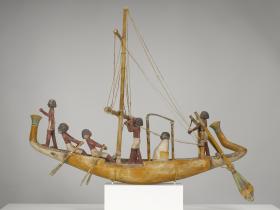- Bring a wheeled chair to an open space in the classroom. Ask for a volunteer and encourage the student to try to move the chair to the other side of the room without touching the floor. Ask the students what would help in moving the chair across the room. Using feet in front to pull back, it is much easier to propel oneself across a space. Define the terms pull and force. Ask the student to use his or her feet to pull himself across the room on the chair. Point out that the student puts his feet in front of himself and pulls them back to move forward. Ask the students how weight would impact the pulling (for example, if you put a stack of books on top of the student). Explain that this is how people row boats. Ask all students to act out putting an oar in water and pulling back to get across a space. Ask students who have canoed or kayaked for stories of paddling. Was it easy or difficult? What made it more easy or more difficult?
- Show Model of a Boat. Tell the students that you will sit in complete silence for three minutes while they observe. Tell them you will ask them what they notice after the time is over. After three minutes ask, What do you see? Students should notice the people with oars, the dead person, and perhaps the people by the masts and the person steering in the back. What is the person in back doing? Tell students about steering the boat from behind to help guide it along. Where can you see the force of pull in this artwork? Tell students that the image depicts rowers carrying a person to the afterlife. Where are the people with the oars looking? Are they rowing with a lot of force? Show a strong pull. What does this indicate? What can we guess about the people rowing the dead person? Are they going fast or slow? The stronger the pull, the faster you go. Show with chair. Explain that art tells a story. By knowing about the force of pull, you know that the rowers are rowing hard. This is a model of a boat that was used on the Nile River by the ancient Egyptians. Many boat models have been found in Egyptian tombs because the Egyptians believed that the dead person had to journey across water to get to the afterlife. What kind of water journey does this sculpture portray? Perhaps they are going through a turbulent river. Perhaps they are rowing fast to get the deceased person to the afterlife quickly.
- Tell students they will re-create the sculpture in groups. Again look closely at the sculpture. Notice the body position of the rowers, the deceased person, the person in front, and the person at the rear. Explain that some students will be the sculptors (the people arranging the others) and the other students will be part of the work. Divide students into groups of 10 to 12. Re-create the sculpture as a living sculpture. Use chairs in a row to represent the boat. Nine students are still: four rowers, one person in front, one dead person, two at the mast, one at the rudder. Pay attention to body position. How hard are you pulling/not pulling?
- Take pictures with a digital camera to show positions to students. Analyze as a class. How does body position show pull? Compare the students’ re-creation to the original sculpture.
- Discuss observation skills with students. How did you know that the wheeled chair couldn’t move at first? How did you know that it moved once pull was involved? You observed like scientists, watching carefully to see changes. Artists also use observation skills, looking closely to better understand a work of art. You used your observation skills at the beginning of the lesson with the chair, during the lesson as you studied the sculpture, and during your group work time as you helped each other re-create the movement of pull.
- Classroom discussion will demonstrate students’ ability to explain how an object moves forward through pulling and articulate how the weight of an object moving forward changes the pull required.
- Discussion will demonstrate students’ ability to identify science in art using the terms pull and force.
- Collaborative work will demonstrate students’ understanding of body position in relationship to the force of pull.
- Class discussion will demonstrate students’ ability to analyze the sculpture in relationship to pull, and their ability to compare and contrast the original sculpture with the living sculpture created by classmates.
Pull: a force drawing someone or something in a particular direction or course of action
Force: strength or energy exerted or brought to bear; cause of motion or change; active power
Sculptor: an artist who makes sculptures
Sculpture: the action or art of processing (as by carving, modeling, or welding) plastic or hard materials into works of art
Rolling chair
Open space
Empty chairs
Digital camera
During the Middle Kingdom, tombs often contained models of boats for the deceased to use in a journey across water, a trip necessary to achieve resurrection in the afterlife. With its round bottom and prow and stern in the shape of stylized papyrus, this model boat resembles actual boats used on the Nile. A pilot at the prow watches the river ahead, and a helmsman with two oars steers from the stern. Two sailors attend the rigging for the sail, while four rowers pull on their oars. The deceased, covered in a white garment, sits impassively under a canopy viewing his progress toward the afterlife.


